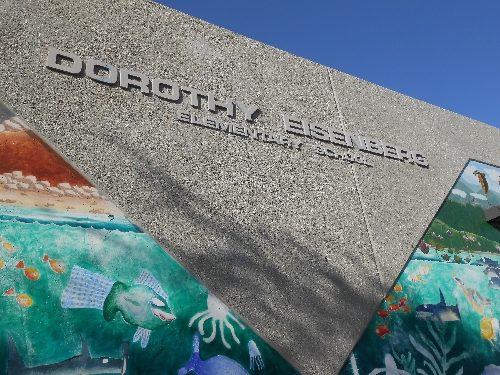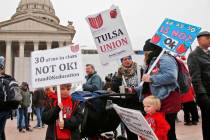Eisenberg Elementary namesake championed ending school segregation
Many schools in the Clark Country School District are named for people who have had an impact on education. Dorothy Eisenberg, 84, who has an elementary school named for her at 7770 W. Delhi Ave., tackled a national issue in local schools: segregation.
It was 1965 when she joined the League of Women Voters. Eisenberg had arrived in the Las Vegas Valley the year before with her husband, Paul, and their children. The move was right after she graduated from Temple University in Philadelphia with an education degree. She was 36.
"We packed up the kids and came that summer," she said, adding that Paul had five children and she had one. "We took the station wagon across the desert. It was July and very hot."
Eisenberg had a difficult transition. She'd come from a cultural metropolis to a dusty desert town. The population of Las Vegas then was 107,616, up from 64,405 five years earlier, according to the U.S. Census Bureau and the Clark County Comprehensive Planning Department.
But a year later, she became active in the community and settled in.
"It was a small town, and you get to know a lot of people that way," she said. "I got interested (in the league) after I saw a notice in the newspaper. It was their second meeting, so I got in on the ground floor."
The league did a study on "know your community," which showed her the diverse kinds of people Las Vegas had attracted. It also pinpointed the valley's shortcomings. The league decided to tackle environmental issues, proposing that the state Legislature pass bills on the issue.
"The first time we went there (Carson City) to help introduce it, nobody was interested," Eisenberg said. "So two years later, when the Legislature met again, we had bills ready to go."
The league had partnered with groups such as the American Association of University Women to deal with air pollution, water and waste issues. One particular concern was with open dumping in the south part of town.
"We were very ambitious in those days," she said. "We actually closed down a dump site in Henderson (after taking) a TV crew so they could see the stuff smoldering out there. It was very successful."
The league also enacted air pollution laws and advocated young people to vote at 18. Previously it had been 21.
"I think everyone takes it for granted now," she said.
Her own issue was segregation in schools. The league's national organization had done a study on the issue and presented the statistics at a national meeting she attended. One of the speakers espoused the need to end segregation in schools.
"We looked around, and we certainly had it here," she said. "So we came back energized from that convention and decided (to act) on that issue."
It was 1971, and she was the league president. Though many people worked on the issue with her, she was seen by the community as its champion. It meant getting input from many people. It also meant death threats.
The first time, she said she received a phone call during the day. It was a man.
"I had two children at home at the time, one was in junior high, one was in high school ... (he) said that (there would be) a bomb in my house," she said.
Eisenberg said it shook her up, and she called the police but got little sympathy. It was so little sympathy that the police never even came to her house to take a report or check the premises. She said she would lie awake at night thinking about the call, wondering if, or when, the man was going to make good on his threat.
"He called again, two days later, and my (younger) daughter answered the phone," Eisenberg said. "He told her, too, that there was going to be a bomb in the house, and she ran out of the house."
Her daughter, Amy, who was 12 at the time, hurried to a neighbor's house and waited there until her parents came home. This time, Eisenberg called the police and made sure she talked to the sheriff directly. Two officers showed up but said there wasn't much they could do.
"There was so much tension in the air," she said. "So many people thought it was not the right thing, what we were doing. There were, like, five different organizations that were formed against this (movement). I think after that I really was even more determined."
The issue was so divisive, it went to the courts after the National Association for the Advancement of Colored People began a lawsuit, one the league supported. It went all the way to the Ninth Circuit Court in San Francisco, one step away from the U.S. Supreme Court.
The result was a convoluted system of busing white and black children to other schools that eventually morphed into today's school system.
"Fair it wasn't, but integration? Yes, it was," Eisenberg said. "I wish we had done better in the courts. I think we had a really good case, but somehow it didn't get across."
She asked the school district to do a follow-up study on how successful the new busing system was, thinking it might lead to revamping it. The district decided not to do a study, something Eisenberg said she regrets not pushing harder to get.
As for her efforts to see the schools integrated, she said, "I'm not sorry that I did it. It took three years, three years of my life ... it was very heady to be a part of something so important. It was very scary, not so much for myself as my family."
Today, Eisenberg visits her namesake school for holidays and various events, such as career day. She arranges for a judge to oversee the student council elections with her, and she hands out school supplies.
Principal Gary Bugash said Eisenberg is very involved and even brings in potato latkes for Hanukkah.
"Because of her accomplishments in the early '70s, she's very well-known, very well connected in the community, and she lends that support to our school that we need," he said. "She's also been a member of the (Clark County Public) Education Foundation for many, many years, and she's always trying to help us, as well as other schools."
"The most fun is when the children come up and hug me," Eisenberg said. "By the time they get to fifth grade, they all know me real well."
Contact Summerlin/Summerlin South View reporter Jan Hogan at jhogan@viewnews.com or 387-2949.
Naming Las Vegas
The history behind the naming of various streets, parks, schools, public facilities and other landmarks in the Las Vegas Valley will continue to be explored in a series of feature stories appearing in View editions published on the first Tuesday of every month.
If you're curious about how or why something got its name, post a comment on our Facebook page, facebook.com/viewnewspapers, or email sblust@viewnews.com.
Thanks for reading View.















